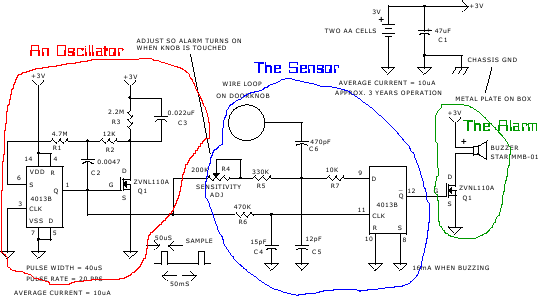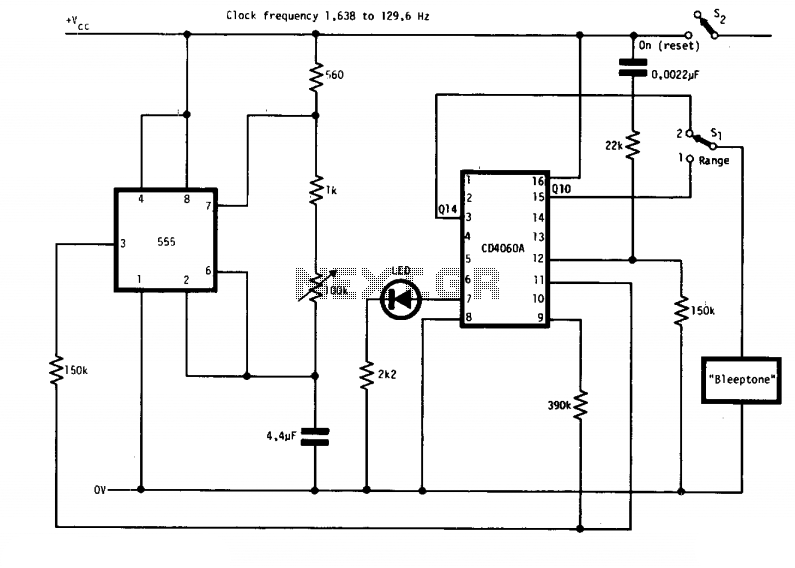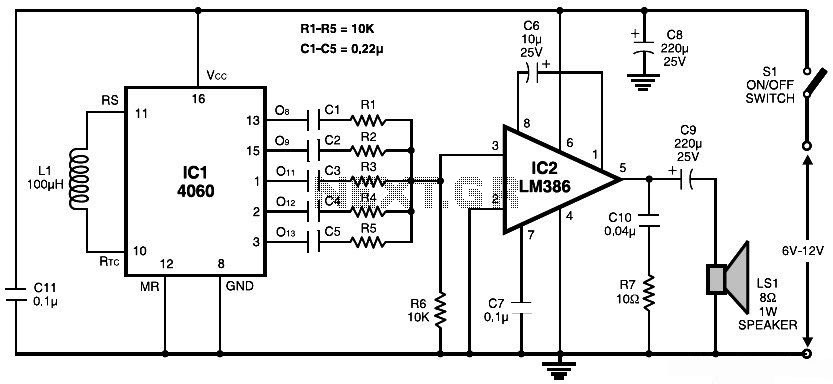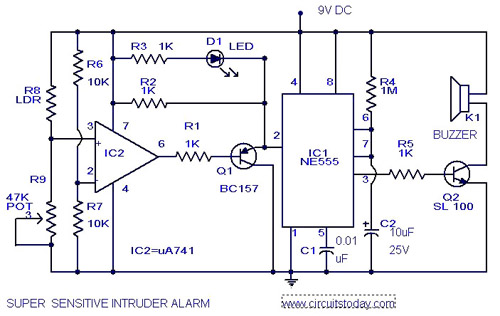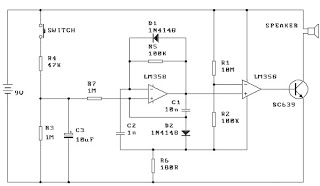
Mains Supply Failure Alarm
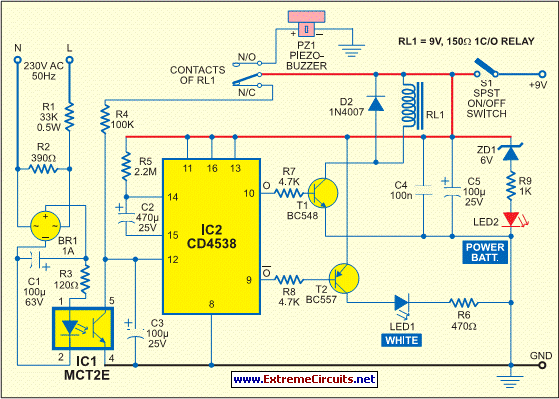
This circuit alerts users with an alarm whenever the AC mains supply fails. It also provides a backup light to assist in locating a torch or generator key in the dark. The circuit is powered by a 9V PP3/6F22 compact battery. The activation of switch S1 supplies power to the circuit. A red LED (LED2), along with a zener diode (ZD1) rated at 6V, indicates the battery power level. Resistor R9 limits the operating current and brightness of LED2. At a battery voltage of 9V, LED2 shines at full intensity, while its brightness diminishes as the voltage drops below 8V, and it turns off when the voltage falls below 7.5V. In the standby state, both LEDs remain off, and the buzzer is silent. The 230V AC mains supply is connected to the mains-voltage detection optocoupler IC MCT2E (IC1) through resistors R1, R2, and R3, a bridge rectifier (BR1), and capacitor C1. When the LED inside optocoupler IC1 illuminates, it activates its internal phototransistor, pulling the clock input pin 12 of IC2 low (connected to 9V via the normally closed contact of relay RL1). Only one monostable configuration of the dual-monostable multivibrator IC CD4538 (IC2) is utilized in this circuit. Upon the loss of mains power, IC2 is triggered after a short duration determined by components C1, R4, and C3. Output pin 10 of IC2 goes high, forward biasing relay driver transistor T1 through resistor R7. Relay RL1 activates, powering the piezo buzzer via its normally open contact for the time-out period set by the monostable multivibrator (approximately 17 minutes). Concurrently, the normally closed contact removes the positive supply to resistor R4. The time-out duration is determined by R5 and C2. Simultaneously, output pin 9 of IC2 goes low, forward biasing PNP transistor T2 to illuminate the white LED (LED1). The light from this backup LED is sufficient for locating the torch or generator key. During the monostable time-out period, the circuit can be deactivated by opening switch S1. The duration of the monostable's on period can be adjusted by changing the values of resistor R5 or capacitor C2. If the mains power does not return before the monostable's on period ends, the timer is retriggered after a brief delay determined by resistors R4 and C3.
The circuit is designed to provide immediate feedback and assistance in the event of a power failure, ensuring that users are alerted through both sound and light. The use of a compact battery allows for portability and ease of installation. The design incorporates safety features such as the use of an optocoupler for mains voltage detection, minimizing the risk of direct exposure to high voltage components.
The inclusion of a zener diode for voltage regulation ensures that the LED power indicator functions reliably, allowing users to monitor battery health effectively. The monostable multivibrator IC CD4538 is chosen for its versatility and reliability in timing applications, providing a precise control over the alarm duration. The relay used in the circuit is rated to handle the current required by the piezo buzzer, ensuring effective activation without excessive power draw.
The circuit can be modified to suit different applications by adjusting the timing components, allowing for customization based on user needs. The backup light feature is particularly beneficial in emergency situations, providing essential illumination to navigate safely in the dark. Overall, this circuit offers a robust solution for power failure alerts and backup lighting, making it a valuable addition to any home or facility.Whenever AC mains supply fails, this circuit alerts you by sounding an alarm. It also provides a backup light to help you find your way to the torch or the generator key in the dark. The circuit is powered directly by a 9V PP3/6F22 compact battery. Pressing of switch S1 provides the 9V power supply to the circuit. A red LED (LED2), in conjunction with zener diode ZD1 (6V), is used to indicate the battery power level. Resistor R9 limits the operating current (and hence the brightness) of LED2. When the battery voltage is 9V, LED2 glows with full intensity. As the battery voltage goes below 8V, the intensity of LED2 decreases and it glows very dimly. LED2 goes off when the battery voltage goes below 7. 5V. Initially, in standby state, both the LEDs are off and the buzzer does not sound. The 230V AC mains is directly fed to mains-voltage detection optocoupler IC MCT2E (IC1) via resistors R1, R2 and R3, bridge rectifier BR1 and capacitor C1. Illumination of the LED inside optocoupler IC1 activates its internal phototransistor and clock input pin 12 of IC2 (connected to 9V via N/C contact of relay RL1) is pulled low.
Note that only one monostable of dual-monostable multivibrator IC CD4538 (IC2) is used here. When mains goes off, IC2 is triggered after a short duration determined by components C1, R4 and C3. Output pin 10 of IC2 goes high to forward bias relay driver transistor T1 via resistor R7. Relay RL1 energises to activate the piezo buzzer via its N/O contact for the time-out period of the monostable multivibrator (approximately 17 minutes). At the same time, the N/C contact removes the positive supply to resistor R4. The time-out period of the monostable multivibrator is determined by R5 and C2. Simultaneously, output pin 9 of IC2 goes low and pnp transistor T2 gets forward biased to light up the white LED (LED1).
Light provided by this back-up LED is sufficient to search the torch or generator key. During the mono time-out period, the circuit can be switched off by opening switch S1. The on` period of the monostable multivibrator may be changed by changing the value of resistor R5 or capacitor C2. If mains doesn`t resume when the on` period of the monostable lapses, the timer is retriggered after a short delay determined by resistor R4 and C3.
🔗 External reference
The circuit is designed to provide immediate feedback and assistance in the event of a power failure, ensuring that users are alerted through both sound and light. The use of a compact battery allows for portability and ease of installation. The design incorporates safety features such as the use of an optocoupler for mains voltage detection, minimizing the risk of direct exposure to high voltage components.
The inclusion of a zener diode for voltage regulation ensures that the LED power indicator functions reliably, allowing users to monitor battery health effectively. The monostable multivibrator IC CD4538 is chosen for its versatility and reliability in timing applications, providing a precise control over the alarm duration. The relay used in the circuit is rated to handle the current required by the piezo buzzer, ensuring effective activation without excessive power draw.
The circuit can be modified to suit different applications by adjusting the timing components, allowing for customization based on user needs. The backup light feature is particularly beneficial in emergency situations, providing essential illumination to navigate safely in the dark. Overall, this circuit offers a robust solution for power failure alerts and backup lighting, making it a valuable addition to any home or facility.Whenever AC mains supply fails, this circuit alerts you by sounding an alarm. It also provides a backup light to help you find your way to the torch or the generator key in the dark. The circuit is powered directly by a 9V PP3/6F22 compact battery. Pressing of switch S1 provides the 9V power supply to the circuit. A red LED (LED2), in conjunction with zener diode ZD1 (6V), is used to indicate the battery power level. Resistor R9 limits the operating current (and hence the brightness) of LED2. When the battery voltage is 9V, LED2 glows with full intensity. As the battery voltage goes below 8V, the intensity of LED2 decreases and it glows very dimly. LED2 goes off when the battery voltage goes below 7. 5V. Initially, in standby state, both the LEDs are off and the buzzer does not sound. The 230V AC mains is directly fed to mains-voltage detection optocoupler IC MCT2E (IC1) via resistors R1, R2 and R3, bridge rectifier BR1 and capacitor C1. Illumination of the LED inside optocoupler IC1 activates its internal phototransistor and clock input pin 12 of IC2 (connected to 9V via N/C contact of relay RL1) is pulled low.
Note that only one monostable of dual-monostable multivibrator IC CD4538 (IC2) is used here. When mains goes off, IC2 is triggered after a short duration determined by components C1, R4 and C3. Output pin 10 of IC2 goes high to forward bias relay driver transistor T1 via resistor R7. Relay RL1 energises to activate the piezo buzzer via its N/O contact for the time-out period of the monostable multivibrator (approximately 17 minutes). At the same time, the N/C contact removes the positive supply to resistor R4. The time-out period of the monostable multivibrator is determined by R5 and C2. Simultaneously, output pin 9 of IC2 goes low and pnp transistor T2 gets forward biased to light up the white LED (LED1).
Light provided by this back-up LED is sufficient to search the torch or generator key. During the mono time-out period, the circuit can be switched off by opening switch S1. The on` period of the monostable multivibrator may be changed by changing the value of resistor R5 or capacitor C2. If mains doesn`t resume when the on` period of the monostable lapses, the timer is retriggered after a short delay determined by resistor R4 and C3.
🔗 External reference
